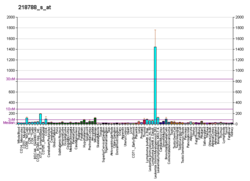SMYD3
SET (Suppressor of variegation, Enhancer of Zeste, Trithorax) and MYND (myeloid-Nervy-DEAF-1) domain-containing protein 3 is a protein that in humans is encoded by the SMYD3 gene.[5]
Function[edit]
SMYD3 is a lysine methyltransferase[6] which specifically methylates H3K4 and H4K5.[7] SMYD3 plays a role in transcriptional regulation as a member of an RNA polymerase complex.[5] It is also involved in cancer regulation.[6]
Expression[edit]
SMYD3 is predominantly expressed in skeletal muscles and the testis.
Interactions[edit]
SMYD3 has been shown to interact with Heat shock protein 90kDa alpha (cytosolic), member A1[8] and POLR2A.[8]
SMYD3 trimethylates a lysine residue on MAP3K2, which causes crosstalk into the MAP kinase signaling pathway in Ras-driven cancers.[9]
Link to cancer[edit]
SMYD3 plays an important role in the progression of cancers in humans. It is highly over expressed in a number of cancers such as liver, breast, and colorectal carcinomas.[10] SMYD3 is known to play a role in lung, esophageal and prostate cancers also.[11]
It has been noted that in lung and colorectal cancers, MAP3K2 methylation by SMYD3 ameliorates PPA2's inhibitory control, which leads to the overriding of apoptosis signals via the activation of the MEK/ERK signalling cascade.[12] Meanwhile, in colon and liver cancers, SMYD3-mediated methylation of H3 promotes RNAP II recruitment and the associated transcription factors from proto-oncogenic regions.[11]
References[edit]
- ^ a b c GRCh38: Ensembl release 89: ENSG00000185420 – Ensembl, May 2017
- ^ a b c GRCm38: Ensembl release 89: ENSMUSG00000055067 – Ensembl, May 2017
- ^ "Human PubMed Reference:". National Center for Biotechnology Information, U.S. National Library of Medicine.
- ^ "Mouse PubMed Reference:". National Center for Biotechnology Information, U.S. National Library of Medicine.
- ^ a b "Entrez Gene: SMYD3 SET and MYND domain containing 3".
- ^ a b Van Aller GS, Reynoird N, Barbash O, Huddleston M, Liu S, Zmoos AF, et al. (April 2012). "Smyd3 regulates cancer cell phenotypes and catalyzes histone H4 lysine 5 methylation". Epigenetics. 7 (4): 340–3. doi:10.4161/epi.19506. PMC 3368817. PMID 22419068.
- ^ Liu Y, Liu H, Luo X, Deng J, Pan Y, Liang H (June 2015). "Overexpression of SMYD3 and matrix metalloproteinase-9 are associated with poor prognosis of patients with gastric cancer". Tumour Biology. 36 (6): 4377–86. doi:10.1007/s13277-015-3077-z. PMID 25627005. S2CID 21827212.
- ^ a b Hamamoto R, Furukawa Y, Morita M, Iimura Y, Silva FP, Li M, et al. (August 2004). "SMYD3 encodes a histone methyltransferase involved in the proliferation of cancer cells". Nature Cell Biology. 6 (8): 731–40. doi:10.1038/ncb1151. PMID 15235609. S2CID 13456531.
- ^ Mazur PK, Reynoird N, Khatri P, Jansen PW, Wilkinson AW, Liu S, et al. (June 2014). "SMYD3 links lysine methylation of MAP3K2 to Ras-driven cancer". Nature. 510 (7504): 283–7. Bibcode:2014Natur.510..283M. doi:10.1038/nature13320. PMC 4122675. PMID 24847881.
- ^ Hamamoto R, Furukawa Y, Morita M, Iimura Y, Silva FP, Li M, et al. (August 2004). "SMYD3 encodes a histone methyltransferase involved in the proliferation of cancer cells". Nature Cell Biology. 6 (8): 731–40. doi:10.1038/ncb1151. PMID 15235609. S2CID 13456531.
- ^ a b Giakountis A, Moulos P, Sarris ME, Hatzis P, Talianidis I (February 2017). "Smyd3-associated regulatory pathways in cancer". Seminars in Cancer Biology. 42: 70–80. doi:10.1016/j.semcancer.2016.08.008. PMID 27554136.
- ^ Colón-Bolea P, Crespo P (December 2014). "Lysine methylation in cancer: SMYD3-MAP3K2 teaches us new lessons in the Ras-ERK pathway". BioEssays. 36 (12): 1162–9. doi:10.1002/bies.201400120. PMID 25382779. S2CID 25659263.
Further reading[edit]
- Lehner B, Semple JI, Brown SE, Counsell D, Campbell RD, Sanderson CM (January 2004). "Analysis of a high-throughput yeast two-hybrid system and its use to predict the function of intracellular proteins encoded within the human MHC class III region". Genomics. 83 (1): 153–67. doi:10.1016/S0888-7543(03)00235-0. PMID 14667819.
- Hamamoto R, Furukawa Y, Morita M, Iimura Y, Silva FP, Li M, et al. (August 2004). "SMYD3 encodes a histone methyltransferase involved in the proliferation of cancer cells". Nature Cell Biology. 6 (8): 731–40. doi:10.1038/ncb1151. PMID 15235609. S2CID 13456531.
- Zhou Z, Ren X, Huang X, Lu L, Xu M, Yin L, et al. (2006). "SMYD3-NY, a novel SMYD3 mRNA transcript variant, may have a role in human spermatogenesis". Annals of Clinical and Laboratory Science. 35 (3): 270–7. PMID 16081583.
- Tsuge M, Hamamoto R, Silva FP, Ohnishi Y, Chayama K, Kamatani N, et al. (October 2005). "A variable number of tandem repeats polymorphism in an E2F-1 binding element in the 5' flanking region of SMYD3 is a risk factor for human cancers". Nature Genetics. 37 (10): 1104–7. doi:10.1038/ng1638. PMID 16155568. S2CID 40468351.
- Hamamoto R, Silva FP, Tsuge M, Nishidate T, Katagiri T, Nakamura Y, Furukawa Y (February 2006). "Enhanced SMYD3 expression is essential for the growth of breast cancer cells". Cancer Science. 97 (2): 113–8. doi:10.1111/j.1349-7006.2006.00146.x. PMID 16441421.
- Wang XQ, Miao X, Cai Q, Garcia-Barcelo MM, Fan ST (March 2007). "SMYD3 tandem repeats polymorphism is not associated with the occurrence and metastasis of hepatocellular carcinoma in a Chinese population". Experimental Oncology. 29 (1): 71–3. PMID 17431393.





